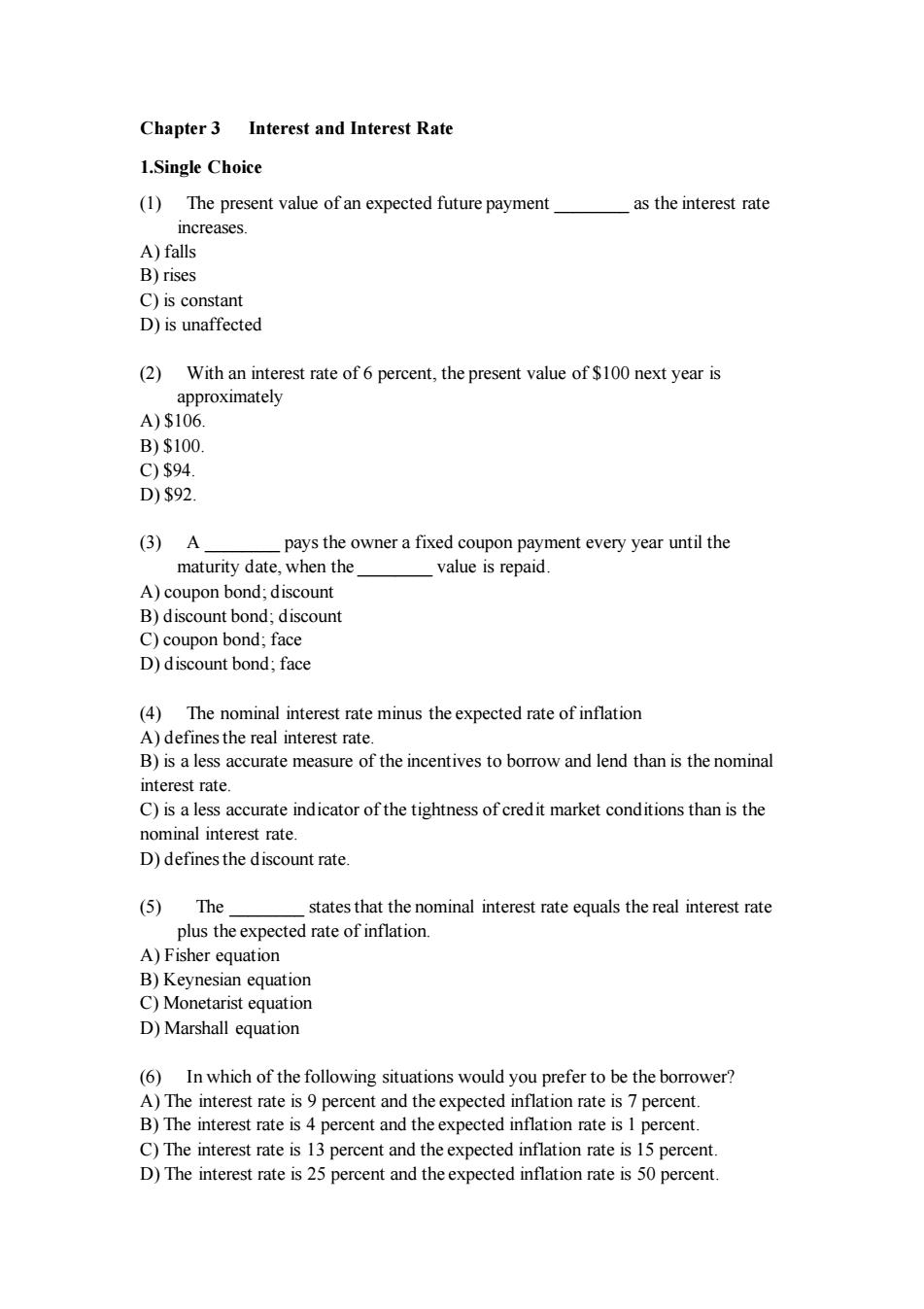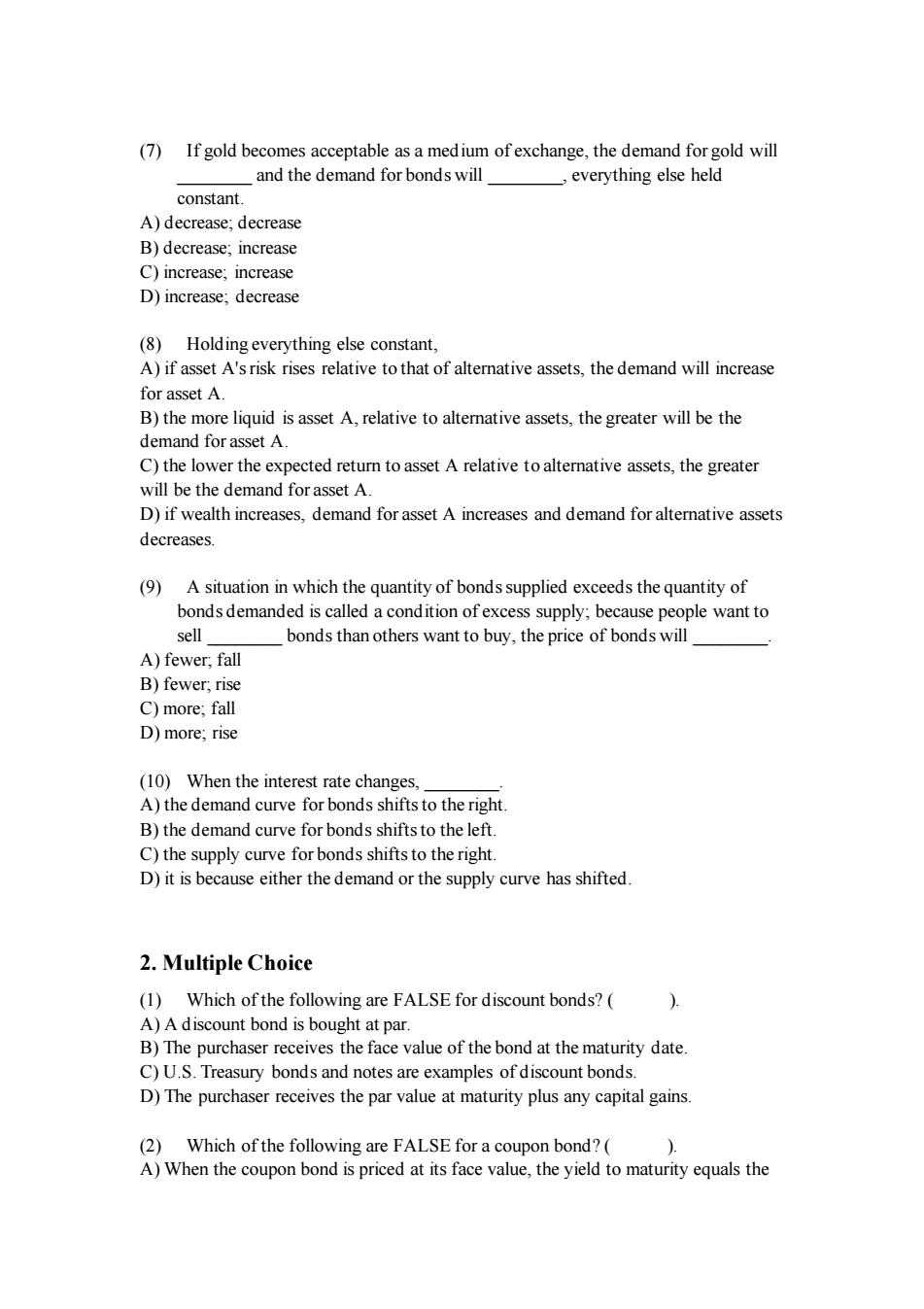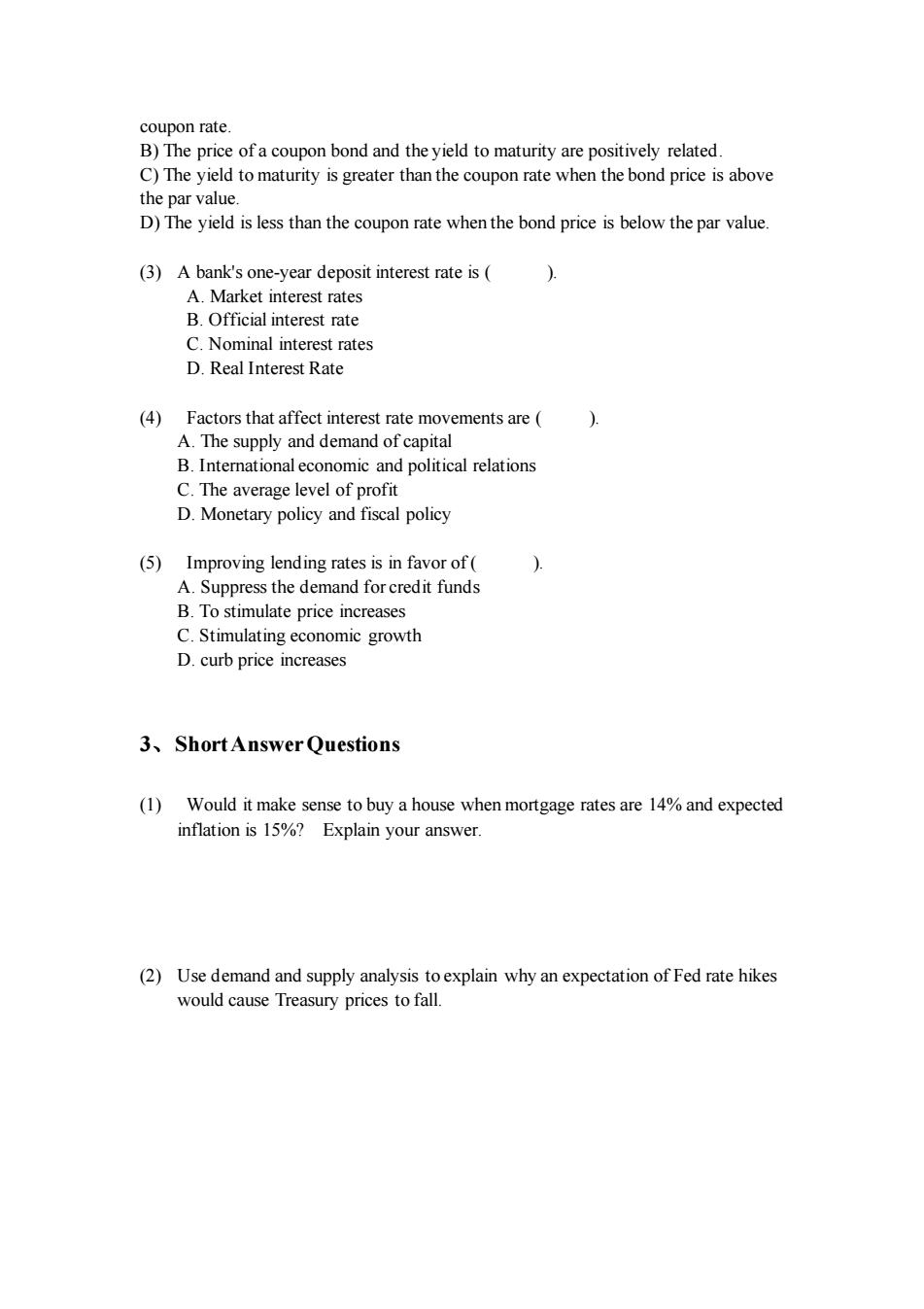
Chapter 3 Interest and Interest Rate 1.Single Choice (1)The present value of an expected future payment as the interest rate increases. A)falls B)rises C)is constant D)is unaffected (2)With an interest rate of 6 percent,the present value of $100 next year is approximately A)$106 B)$100 C)$94 D)$92. (3)A pays the owner a fixed coupon payment every year until the maturity date,when the value is repaid. A)coupon bond;discount B)discount bond;discount C)coupon bond;face D)discount bond;face (4)The nominal interest rate minus the expected rate of inflation A)defines the real interest rate. B)is a less accurate measure of the incentives to borrow and lend than is the nominal interest rate. C)is a less accurate indicator of the tightness of credit market conditions than is the nominal interest rate. D)defines the discount rate. (5)The states that the nominal interest rate equals the real interest rate plus the expected rate of inflation. A)Fisher equation B)Keynesian equation C)Monetarist equation D)Marshall equation (6)In which of the following situations would you prefer to be the borrower? A)The interest rate is 9 percent and the expected inflation rate is 7 percent. B)The interest rate is 4 percent and the expected inflation rate is 1 percent C)The interest rate is 13 percent and the expected inflation rate is 15 percent. D)The interest rate is 25 percent and the expected inflation rate is 50 percent
Chapter 3 Interest and Interest Rate 1.Single Choice (1) The present value of an expected future payment ________ as the interest rate increases. A) falls B) rises C) is constant D) is unaffected (2) With an interest rate of 6 percent, the present value of $100 next year is approximately A) $106. B) $100. C) $94. D) $92. (3) A ________ pays the owner a fixed coupon payment every year until the maturity date, when the ________ value is repaid. A) coupon bond; discount B) discount bond; discount C) coupon bond; face D) discount bond; face (4) The nominal interest rate minus the expected rate of inflation A) defines the real interest rate. B) is a less accurate measure of the incentives to borrow and lend than is the nominal interest rate. C) is a less accurate indicator of the tightness of credit market conditions than is the nominal interest rate. D) defines the discount rate. (5) The ________ states that the nominal interest rate equals the real interest rate plus the expected rate of inflation. A) Fisher equation B) Keynesian equation C) Monetarist equation D) Marshall equation (6) In which of the following situations would you prefer to be the borrower? A) The interest rate is 9 percent and the expected inflation rate is 7 percent. B) The interest rate is 4 percent and the expected inflation rate is 1 percent. C) The interest rate is 13 percent and the expected inflation rate is 15 percent. D) The interest rate is 25 percent and the expected inflation rate is 50 percent

(7)If gold becomes acceptable as a med ium of exchange,the demand for gold will and the demand for bonds will,everything else held constant. A)decrease;decrease B)decrease;increase C)increase;increase D)increase;decrease (8)Holding everything else constant, A)if asset A's risk rises relative to that of alternative assets,the demand will increase for asset A. B)the more liquid is asset A,relative to alternative assets,the greater will be the demand for asset A. C)the lower the expected return to asset A relative to alternative assets,the greater will be the demand for asset A. D)if wealth increases,demand for asset A increases and demand for alternative assets decreases. (9) A situation in which the quantity of bonds supplied exceeds the quantity of bonds demanded is called a condition of excess supply;because people want to sell bonds than others want to buy,the price of bonds will A)fewer;fall B)fewer;rise C)more;fall D)more;rise (10)When the interest rate changes, A)the demand curve for bonds shifts to the right B)the demand curve for bonds shifts to the left. C)the supply curve for bonds shifts to the right. D)it is because either the demand or the supply curve has shifted. 2.Multiple Choice (1)Which of the following are FALSE for discount bonds?(). A)A discount bond is bought at par. B)The purchaser receives the face value of the bond at the maturity date. C)U.S.Treasury bonds and notes are examples of discount bonds D)The purchaser receives the par value at maturity plus any capital gains. (2)Which of the following are FALSE for a coupon bond?(). A)When the coupon bond is priced at its face value,the yield to maturity equals the
(7) If gold becomes acceptable as a medium of exchange, the demand for gold will ________ and the demand for bonds will ________, everything else held constant. A) decrease; decrease B) decrease; increase C) increase; increase D) increase; decrease (8) Holding everything else constant, A) if asset A's risk rises relative to that of alternative assets, the demand will increase for asset A. B) the more liquid is asset A, relative to alternative assets, the greater will be the demand for asset A. C) the lower the expected return to asset A relative to alternative assets, the greater will be the demand for asset A. D) if wealth increases, demand for asset A increases and demand for alternative assets decreases. (9) A situation in which the quantity of bonds supplied exceeds the quantity of bonds demanded is called a condition of excess supply; because people want to sell ________ bonds than others want to buy, the price of bonds will ________. A) fewer; fall B) fewer; rise C) more; fall D) more; rise (10) When the interest rate changes, ________. A) the demand curve for bonds shifts to the right. B) the demand curve for bonds shifts to the left. C) the supply curve for bonds shifts to the right. D) it is because either the demand or the supply curve has shifted. 2. Multiple Choice (1) Which of the following are FALSE for discount bonds? ( ). A) A discount bond is bought at par. B) The purchaser receives the face value of the bond at the maturity date. C) U.S. Treasury bonds and notes are examples of discount bonds. D) The purchaser receives the par value at maturity plus any capital gains. (2) Which of the following are FALSE for a coupon bond? ( ). A) When the coupon bond is priced at its face value, the yield to maturity equals the

coupon rate. B)The price of a coupon bond and the yield to maturity are positively related. C)The yield to maturity is greater than the coupon rate when the bond price is above the par value. D)The yield is less than the coupon rate when the bond price is below the par value. (3)A bank's one-year deposit interest rate is () A.Market interest rates B.Official interest rate C.Nominal interest rates D.Real Interest Rate (4)Factors that affect interest rate movements are () A.The supply and demand of capital B.International economic and political relations C.The average level of profit D.Monetary policy and fiscal policy (5)Improving lending rates is in favor of( A.Suppress the demand for credit funds B.To stimulate price increases C.Stimulating economic growth D.curb price increases 3.ShortAnswer Questions (1)Would it make sense to buy a house when mortgage rates are 14%and expected inflation is 15%?Explain your answer. (2)Use demand and supply analysis to explain why an expectation of Fed rate hikes would cause Treasury prices to fall
coupon rate. B) The price of a coupon bond and the yield to maturity are positively related. C) The yield to maturity is greater than the coupon rate when the bond price is above the par value. D) The yield is less than the coupon rate when the bond price is below the par value. (3) A bank's one-year deposit interest rate is ( ). A. Market interest rates B. Official interest rate C. Nominal interest rates D. Real Interest Rate (4) Factors that affect interest rate movements are ( ). A. The supply and demand of capital B. International economic and political relations C. The average level of profit D. Monetary policy and fiscal policy (5) Improving lending rates is in favor of ( ). A. Suppress the demand for credit funds B. To stimulate price increases C. Stimulating economic growth D. curb price increases 3、Short Answer Questions (1) Would it make sense to buy a house when mortgage rates are 14% and expected inflation is 15%? Explain your answer. (2) Use demand and supply analysis to explain why an expectation of Fed rate hikes would cause Treasury prices to fall